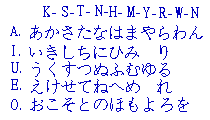Written Japanese
Hiragana and Katakana
Introduction
Japanese is written using three different orthographies. They are the Kanji
or Chinese characters, the hiragana and katakana. Hiragana and katakana are
the syllables which are used in japanese speech, each one of these represents
a sound value. Both sets of syllables are derived from chinese character,
hiragana is more cursive in appearance, whilst katakan is much more angular.
In modern japanese, they have seperate uses. Hiragana is used to transcribe
the various particles of everyday Japanese, katakana is used for words which
have a foreign origin, and the kanji provide form and meaning to ideas expresed.
Syllabaries
The two syllable groups can be called collectively "kana". The kana sets are
shown in the images below.

 The table form shows the intial consonant along the top and vowels vertically down the left hand side which combine to produce a given syllable.
The table form shows the intial consonant along the top and vowels vertically down the left hand side which combine to produce a given syllable.
In Japanese, these are the 'gojuuon' or the fifty sounds. There are also other sounds that have not been represented here, they begin with g,z,d,b, and p. These are formed as follows:
g = k + ¨, z = s + ¨, d = t + ¨, b = h + ¨, p = h + °
This is by no means an exhaustive list of the sound combinations.
Kanji
Kanji are Chinese characters that the Japanese started to use about 1500 years ago. For nearly all cases, these were imported from China, though a few have been invented in Japan and then introduced into China. With the exception of a few, all the rest have at least one Chinese pronunciation. When a character was introduced to Japanese, it would depend from where the learner first learnt it, and at what time in history. This is because in different areas of China, the dialects are different although there is a common script. As time went on the pronunciation of Chinese would have changed from that which was spoken by the Chinese forefathers. Hence the many Chinese peonunciations for one character. In some well used ones, there are as many as two hundred pronunciations. But luckily with the language reforms of the post war Japanese government, dictionary listings have limited them. It is noted here that older dictionaries contained archaic means no longer in common useage, whereas newer compound phrases or words are hard to find except the much more recently published works.
A general distinction for Kanji Compounds.
The native Japanese word has gradually been asociated with the Chinese character. So 'yama' meaning mountain would share same kanji with the original chinese character whose pronunciation is 'san'. For this example the use of which pronunciation would depend on the context the word found itself in. In compounds however, there is a choice of using totally chinese derived pronunciations, totally japanese derived pronunciations, or more complex, a mixture of the two. There is a nother case to complicate this, and that is to give a foreign word a kanji compound, so neither chinese or japanese readings apply. In most cases, as a rule of thumb, if there is a compound of chinese kanji characters, then a chinese reading is suitable. Exceptions therefore must be learnt by hard work. It will soon be realised that even this rough guide fails on many occasions due to the peculiarities which make Japanese so difficult for learners.
Language Reforms
Before language reforms, the use many thousands of Chinese characters was so extensive that there was a need to have a standard. The government produced a list of 1945 common chinese characters for use in the media, and these were the Touyou Kanji or the Standard Kanji. The use of kana had previously been mixed, so that katakana or hiragana were used for the paticles of speech in writing, and there were no distinctions in the writing of foreign words. After reformation, the above (see intoduction) system was implemented. In the 1980's a newer list was drawn up and certain characters were dropped and replacements were given. Additional characters were added for use in Japanese names.
A note on Japanese Personal and Place names.
In the case names, the rule of thumb is that kanji compounds, japanese readings for the separate characters are used for surnames with a good degree of certainty. Special readings occur, however, for given names, so that it is uncertain which one is applicable. On forms and documents, there is a special line for 'furigana' which are small versions of the kana, for inserting above the name. This is one way to have a correct pronunciation! Words with similar meanings have similar Japanese readings, so there are many synonyms.
Chinese Writing :
Japanese Pages :
Dylan's HomePage
This page was last updated on
Saturday 18 January 1997.
© Dylan W.H.S. 1996-1997
E-mail me here if you like...

 The table form shows the intial consonant along the top and vowels vertically down the left hand side which combine to produce a given syllable.
The table form shows the intial consonant along the top and vowels vertically down the left hand side which combine to produce a given syllable.

 The table form shows the intial consonant along the top and vowels vertically down the left hand side which combine to produce a given syllable.
The table form shows the intial consonant along the top and vowels vertically down the left hand side which combine to produce a given syllable.